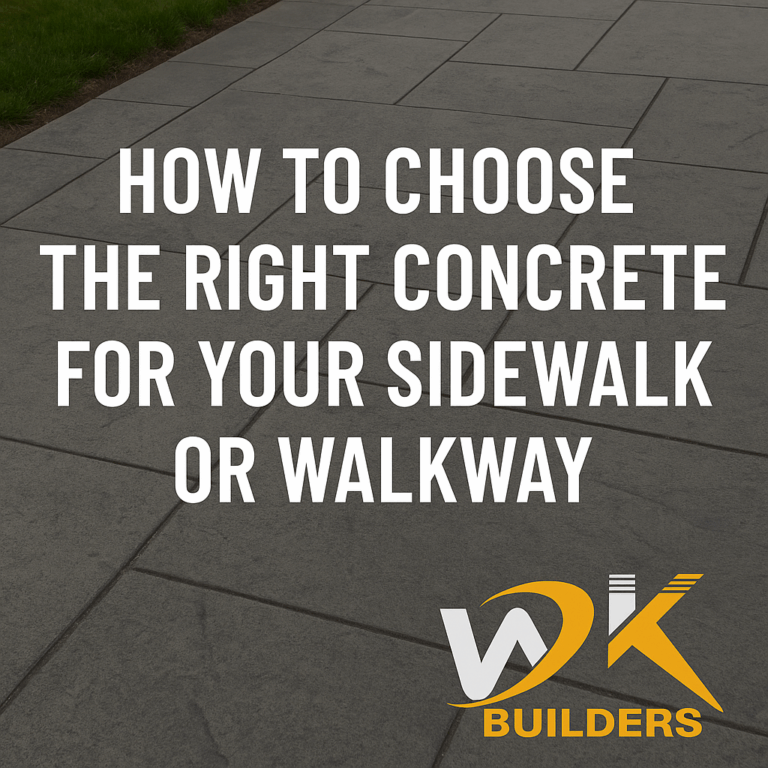Stamped vs Poured Concrete is a key decision every homeowner faces when upgrading or installing a new concrete driveway. Each option presents unique advantages that influence the driveway’s appearance, durability, maintenance, and cost. At West Key Builders (WKB), we specialize in expert driveway installation and repair, helping you choose the best solution for your home’s style and functionality. In this guide, we explore the essential differences between Stamped vs Poured Concrete so you can make a confident and informed decision.
What is Poured Concrete?
Poured concrete is a traditional method where a concrete mixture is poured into a framed mold to form a flat slab. Once cured, it results in a seamless, smooth finish that’s ideal for driveways, walkways, and patios. This type of concrete is often chosen for its simplicity and strength, making it a popular choice for homeowners who want a no-fuss, durable surface.
Benefits of Poured Concrete:
- Durability: Designed to withstand heavy traffic and variable weather.
- Low Maintenance: Simple to clean with occasional sealing.
- Cost-Effective: More affordable than decorative alternatives.
- Quick Installation: Requires less time to pour and finish.
Though reliable, poured concrete may develop visible cracks without proper control joints or a stable subgrade. However, these cracks can often be minimized with proper planning and reinforcement during the installation process.
What is Stamped Concrete?
Stamped concrete offers a decorative twist by imprinting patterns into freshly poured concrete. These textures mimic high-end materials like brick, stone, or tile while offering the strength of concrete. Stamped concrete is ideal for homeowners seeking a premium look without the cost of natural materials.
Benefits of Stamped vs Poured Concrete:
- Visual Appeal: Achieve the look of natural stone or pavers.
- Variety of Designs: Available in numerous colors and textures.
- Seamless Finish: Eliminates gaps found in real stone or tile.
However, stamped concrete tends to be more expensive due to added labor and finishing materials. It may also require more frequent maintenance to preserve its decorative surface, including resealing to prevent fading and wear from the elements.
Stamped vs Poured Concrete: Side-by-Side Comparison
To better understand stamped vs. poured concrete, compare them across these essential categories:
- Appearance: Poured concrete is sleek and minimal; stamped concrete mimics upscale materials like stone, brick, or slate.
- Installation Time: Poured is quicker; stamped takes longer due to stamping, coloring, and curing processes.
- Cost: Poured concrete is more budget-friendly; Stamped vs Poured Concrete, has higher upfront costs due to customization.
- Maintenance: Both require sealing, but stamped may need more frequent attention to maintain its finish.
- Durability: Both are strong and long-lasting; poured may show cracks more easily, while stamped can become slippery if not textured properly.
Which Concrete Option is Best for Your Driveway?
When weighing stamped vs poured concrete, your decision depends on your project goals:
- Choose poured concrete if you value affordability, speed, and simplicity.
- Choose stamped concrete if you want a high-end aesthetic and are willing to invest in long-term maintenance.
- In colder climates, poured concrete may resist freeze-thaw damage more effectively, particularly when reinforced.
Our team at West Key Builders helps you weigh the pros and cons based on your driveway’s use, location, and design vision.
Driveway Installation Experts at West Key Builders
At West Key Builders (WKB), we bring years of hands-on experience in concrete driveway solutions. Whether you’re drawn to the clean, reliable look of poured concrete or the custom style of stamped concrete, we’ll bring your vision to life with lasting quality. We focus on proper grading, subgrade prep, and high-performance materials to ensure your driveway stands the test of time.
Check out our high-quality driveway installations to see real-life examples of stamped vs poured concrete projects.
Contact us today for a personalized quote and expert advice on your next driveway installation.


